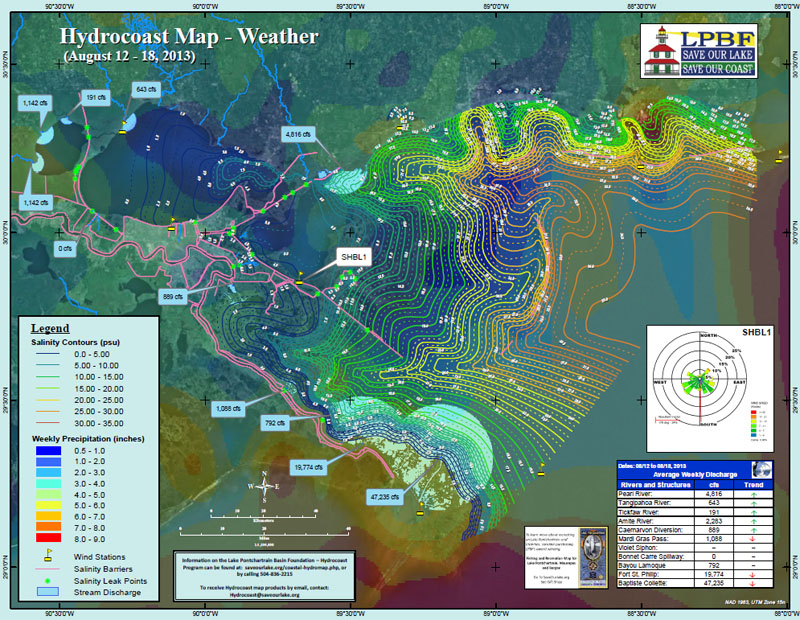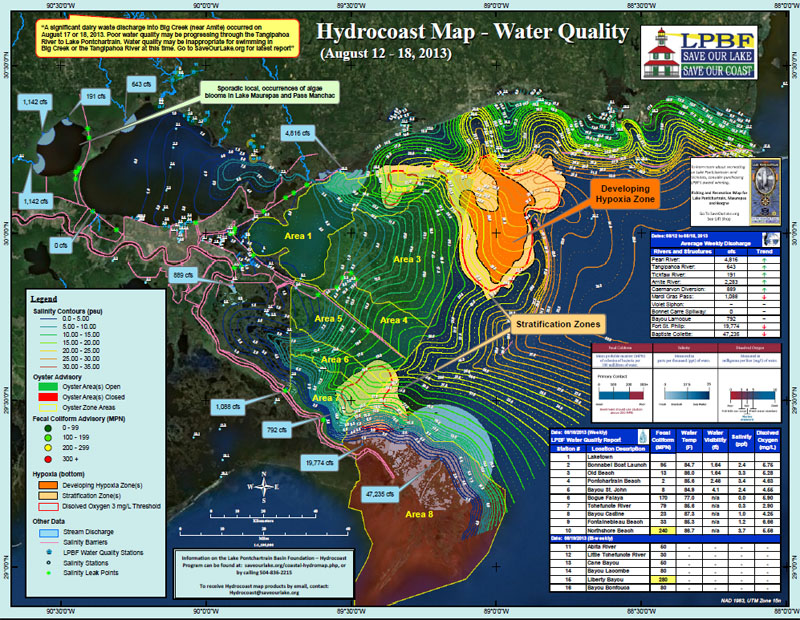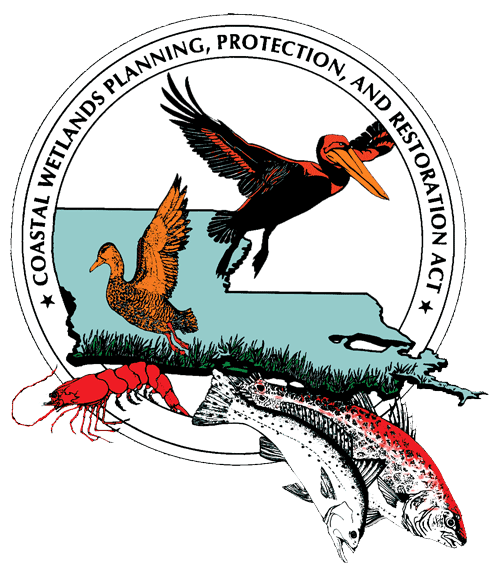LPBF announces the release of Hydrocoast maps for the Period of August 12th to August 18th
The Hydrocoast program collects a number of environmentally dynamic datasets in an effort to monitor the condition (salinity component) of the basin's estuaries. Wind, rain, tides and freshwater influx from streams and diversions are variables that cause salinity fluctuation, and play a vital role in the health of the basin's estuaries. The Hydrocoast program monitors these variables over a seven day period and produces bi-monthly map products showing the movement of water and salinity across the basin (using field data, MODIS, sattelite imagery, precipitation data, wind data and permanent monitoring stations in the basin such as USGS buoys, Coastwide Reference Monitoring System (CRMS), etc.). As a tool, these map products can be used for scientific discussion, restoration planning between state and federal agencies, and by the commercial and recreational fishery community.
In this Hydrocoast period more saline water returned to the eastern side of Lake Pontchartrain, entering through the Rigolets and Chef Menteur passes, increasing from 4 ppt during the last Hydrocoast period to 7 ppt during this period. The western half of the lake became fresher, most likely due to increased discharge from local rivers due to increased rainfall. Lake Borgne salinity also increased, with 6ppt water working in to the lobes of the lake where it was less than 3ppt during the last Hydrocoast period. Salinities also increased in Chandeleur Sound. Average daily discharge for the week increased in local rivers during this Hydrocoast due to increased rainfall but decreased in the openings along the river, due to a decreasing river stage. Average daily discharge difference between last Hydrocoast and the current was:
During this Hydrocoast period, oyster harvest area 8 (spanning the Bird's Foot Delta) was closed while all other areas east of the Mississippi River remained open. During this period, elevated fecal coliform counts were found at Northshore Beach and Liberty Bayou. There were also some local, sporadic occurrences of algae blooms reported in Lake Maurepas and Pass Manchac.
A significant dairy waste discharge into Big Creek (near Amite) occurred on August 17 or 18, 2013. Poor water quality may be progressing through the Tangipahoa River to Lake Pontchartrain. Water quality may be inappropriate for swimming in Big Creek or the Tangipahoa River at this time. Go to SaveOurLake.org for latest report.
To receive Hydrocoast products by email please email Hydrocoast@saveourlake.org with "subscribe" in the subject line. For more information on the Hydrocoast maps and to view archived maps please visit http://saveourlake.org/coastal-hydromap.php
The Hydrocoast program collects a number of environmentally dynamic datasets in an effort to monitor the condition (salinity component) of the basin's estuaries. Wind, rain, tides and freshwater influx from streams and diversions are variables that cause salinity fluctuation, and play a vital role in the health of the basin's estuaries. The Hydrocoast program monitors these variables over a seven day period and produces bi-monthly map products showing the movement of water and salinity across the basin (using field data, MODIS, sattelite imagery, precipitation data, wind data and permanent monitoring stations in the basin such as USGS buoys, Coastwide Reference Monitoring System (CRMS), etc.). As a tool, these map products can be used for scientific discussion, restoration planning between state and federal agencies, and by the commercial and recreational fishery community.
In this Hydrocoast period more saline water returned to the eastern side of Lake Pontchartrain, entering through the Rigolets and Chef Menteur passes, increasing from 4 ppt during the last Hydrocoast period to 7 ppt during this period. The western half of the lake became fresher, most likely due to increased discharge from local rivers due to increased rainfall. Lake Borgne salinity also increased, with 6ppt water working in to the lobes of the lake where it was less than 3ppt during the last Hydrocoast period. Salinities also increased in Chandeleur Sound. Average daily discharge for the week increased in local rivers during this Hydrocoast due to increased rainfall but decreased in the openings along the river, due to a decreasing river stage. Average daily discharge difference between last Hydrocoast and the current was:
During this Hydrocoast period there was heavy rainfall over parts of the Pontchartrain basin, near Maurepas and the Bird's Foot Delta, but rainfall was experienced over the entire basin at some point during this Hydrocoast period. Rainfall ranged from 1 to 7 inches. The resultant winds for this period were mostly from the southwest and southeast but there were some winds expereinced from every direction except north during this period. Wind speeds ranged from 1 to 11 m/s (2 to 24 miles/hr).
- Pearl River = 3,145 to 4,816 cfs
- Tangipahoa = 277 to 643 cfs
- Tickfaw = 111 to 191 cfs
- Amite = 1,119 to 2,283 cfs
- Caernarvon Diversion = 673 to 889 cfs
- Mardi Gras Pass = 1,320 to 1,088 cfs
- Violet Siphon = N/A cfs
- Bonnet Carré Spillway = 0 to 0 cfs
- Fort St. Philip = 25,683 to 19,774 cfs
- Baptiste Collete = 59,360 to 47,235cfs
During this Hydrocoast period, oyster harvest area 8 (spanning the Bird's Foot Delta) was closed while all other areas east of the Mississippi River remained open. During this period, elevated fecal coliform counts were found at Northshore Beach and Liberty Bayou. There were also some local, sporadic occurrences of algae blooms reported in Lake Maurepas and Pass Manchac.
A significant dairy waste discharge into Big Creek (near Amite) occurred on August 17 or 18, 2013. Poor water quality may be progressing through the Tangipahoa River to Lake Pontchartrain. Water quality may be inappropriate for swimming in Big Creek or the Tangipahoa River at this time. Go to SaveOurLake.org for latest report.
To receive Hydrocoast products by email please email Hydrocoast@saveourlake.org with "subscribe" in the subject line. For more information on the Hydrocoast maps and to view archived maps please visit http://saveourlake.org/coastal-hydromap.php




###
To subscribe, send an email from the address you want subscribed to: ListServer@nwrccom.cr.usgs.gov with the subject "subscribe cwppra" without the quotation marks. |
Connect with us: |
|
Submit CWPPRA Newsflash Requests to: ruckstuhlc@usgs.gov |
||

